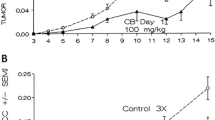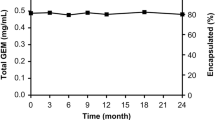Abstract
DE-310, a new macromolecular prodrug, was designed to enhance the pharmacological profiles of a novel camptothecin analog (DX-8951f), and a single treatment with DE-310 exhibits a similar or greater therapeutic effect than do optimally scheduled multiple administrations of DX-8951f in several types of tumors. In this study, the drug-release mechanism by which DE-310 excites antitumor activity was investigated in Meth A cells, a malignant ascites model of murine fibrosarcoma. A single i.v. injection of DE-310 at the maximum tolerated dose (MTD) prolonged survival of Meth A-bearing mice by 300%. DX-8951 and glycyl-8951 (G-DX-8951), enzymatic cleavage products of DE-310, were detected in serum and ascites fluid, and also in the culture medium of Meth A ascites cells incubated in vitro with DE-310. The total amounts of DX-8951, G-DX-8951, and conjugated DX-8951 in Meth A tumor cells were three times higher than that in macrophages. Furthermore, DX-8951-related fluorescence was observed in Meth A ascites cells obtained from Meth A-bearing mice that had received DE-310 or CM-Dex-PA-DX-8951 that does not release free DX-8951. DX-8951-related fluorescence was also observed at the site of lysosomes in cells incubated in vitro with DE-310 at 37°C, but not in those incubated at 4°C. Drugs were released from DE-310 by cysteine proteinase prepared from Meth A tumor tissue. These results suggest that the mechanism by which DX-8951 is released from DE-310 in vivo is involved in the process of uptake of DE-310 into tumor or macrophages, digestion by intracellular lysosomal cysteine proteinase, and subsequent secretion of the drugs.









Similar content being viewed by others
References
Kawato Y, Terasawa H (1997) Recent advances in the medical chemistry and pharmacology of camptothecin. Prog Med Chem 34:69–109
Mitsui I, Kumazawa E, Hirota Y, Aonuma M, Sugimori M, Ohsuki S, Uoto K, Ejima A, Terasawa H, Sato K (1995) A new water-soluble camptothecin derivative, DX-8951f, exhibits potent antitumor activity against human tumors in vitro and in vivo. Jpn J Cancer Res 86:776–782
Joto N, Ishii M, Minami M, Kuga H, Mitsui I, Tohgo A (1997) DX-8951f, a water-soluble camptothecin analog, exhibits potent antitumor activity against a human lung cancer cell line and its SN-38-resistant variant. Int J Cancer 72:680–686
Takiguchi S, Kumazawa E, Shimazoe T, Tohgo A, Kono A (1997) Antitumor effect of DX-8951, a novel camptothecin analog, on human pancreatic tumor cells and their CPT-11-resistant variants cultured in vitro and xenografted into nude mice. Jpn J Cancer Res 88:760–769
Kumazawa E, Jimbo T, Ochi Y, Tohgo A (1998) Potent and broad antitumor effects of DX-8951f, a water-soluble camptothecin derivative, against various human tumors xenografted in nude mice. Cancer Chemother Pharmacol 42:210–220
Matsumura Y, Maeda H (1986) A new concept for macromolecular therapeutics in cancer chemotherapy: mechanism of tumoritropic accumulation of proteins and the antitumor agent smancs. Cancer Res 46:6387–6392
Maeda H, Matsumura Y (1989) Tumoritropic and lymphotropic principles of macromolecular drugs. Crit Rev Ther Drug Carrier Syst 6:193–210
Maeda H, Wu J, Sawa T, Matsumura Y, Hori K (2000) Tumor vascular permeability and EPR effect in macromolecular therapeutics: a review. J Control Release 65:271–284
Maeda H (2001) The enhanced permeability and retention (EPR) effect in tumor vasculature: the key role of tumor-selective macromolecular drug targeting. Adv Enzyme Regul 41:189–207
Goldstein IJ, Hay GW, Lewis A, Smith F (1965) Controlled degradation of polysaccharides by periodate oxidation, reduction, and hydrolysis. Methods Carbohydr Chem 5:361–370
Inoue K, Kumazawa E, Kuga H, Susaki H, Masubuchi N, Kajimura T (2003) CM-dextran-polyalcohol-camptothecin conjugate; DE-310 with a novel carrier system and its preclinical data. Adv Exp Med Biol 519:145–153
Chambers AF, Matrisian LM (1997) Changing views of the role of matrix metalloproteinases in metastasis. J Natl Cancer Inst 89:1260–1270
Mai J, Waisman DM, Sloane BF (2000) Cell surface complex of cathepsin B/annexin II tetramer in malignant progression. Biochem Biophys Acta 1477:215–230
Duncan R (1997) Polymer therapeutics for tumor specific delivery. Chem Ind 7:262–264
Feldman GB, Knapp RC, Order SE, Hellman S (1972) The role of lymphatic obstruction in the formation of ascites in a murine ovarian carcinoma. Cancer Res 32:1663–1666
Nagy JA, Herzberg KT, Dvorak JM, Dvorak HF (1993) Pathogenesis of malignant ascites formation: initiating events that lead to fluid accumulation. Cancer Res 53:2631–2643
Feldman GB (1975) Lymphatic obstruction in carcinomatous ascites. Cancer Res 35:325–332
Senger DR, Peruzzi CA, Feder J, Dvorak HF (1986) A highly conserved vascular permeability factor secreted by a variety of human and rodent tumor cell lines. Cancer Res 46:5629–5632
Senger DR, Connoly DT, Van De Water L, Dvorak HF (1990) Purification and NH2-terminal amino acid sequence of guinea pig tumor-secreted vascular permeability factor. Cancer Res 50:1774–1778
Maeda H, Fang J, Inutsuka T, Kitamoto Y (2003) Vascular permeability enhancement in solid tumor: various factors, mechanisms involved and its implications. Int Immunopharmacol 3:319–328
Okuno S, Harada M, Yano T, Yano S, Kiuchi S, Tsuda N, Sakamura Y, Imai J, Kawaguchi T, Tsujihara K (2000) Complete regression of xenografted human carcinomas by camptothecin analogue-carboxymethyl dextran conjugate (T-0128). Cancer Res 60:2988–2995
Harada M, Imai J, Okuno S, Suzuki T (2000) Macrophage-mediated activation of camptothecin analogue T-2513-carboxymethyl dextran conjugate (T-0128): possible cellular mechanism for antitumor activity. J Control Release 69:389–397
Harada M, Sakakibara H, Yano T, Suzuki T, Okuno S (2000) Determinants for the drug release from T-0128, camptothecin analogue-carboxymethyl dextran conjugate. J Control Release 69:399–412
Harada M, Murata J, Sakamura Y, Sakakibara H, Okuno S, Suzuki T (2001) Carrier and dose effects on the pharmacokinetics of T-0128, a camptothecin analogue-carboxymethyl dextran conjugate, in non-tumor- and tumor-bearing rats. J Control Release 71:71–86
Smith GJ, Bagnell CR, Bakewell WE, Black KA, Bouldin TW, Earnhardt TS, Hook GER, Pryzwansky KB (1991) Application of confocal scanning microscopy in experimental pathology. J Electron Microsc Tech 18:38–49
Oyama H, Nagane M, Shibui S, Nomura K, Mukai K (1992) Intracellular distribution of CPT-11-resistant cells with confocal laser scanning microscopy. Jpn J Clin Oncol 22:331–334
Springer T, Galfre Ģ, Secher DS, Milstein C (1979) Mac 1: a macrophage differentiation antigen identified by monoclonal antibody. Eur J Immunol 9:301–306
Denise RS, Frank MG (1981) Phagocytosis requires repeated triggering of macrophage phagocytic receptors during particle ingestion. Nature 289:409–411
O’sllivan C, Lewis CE (1994) Tumor-associated leucocytes: friends or foes in breast carcinoma. J Pathol 172:229–235
Soyez H, Schacht E, Vanderkerken S (1996) The crucial role of spacer groups in macromolecular prodrug design. Adv Drug Deliv Rev 21:81–106
Kirschke H, Barrett AJ, Rawlings ND (1995) Proteinases 1: lysosomal cysteine proteinases. Protein profile 2. Academic Press, London, pp 1587–1643
Acknowledgements
The authors wish to thank Mrs. M. Nakata for her excellent technical contribution and Dr. N. Tanaka and Dr. K. Inoue for their advice concerning this study.
Author information
Authors and Affiliations
Corresponding author
Rights and permissions
About this article
Cite this article
Ochi, Y., Shiose, Y., Kuga, H. et al. A possible mechanism for the long-lasting antitumor effect of the macromolecular conjugate DE-310: mediation by cellular uptake and drug release of its active camptothecin analog DX-8951. Cancer Chemother Pharmacol 55, 323–332 (2005). https://doi.org/10.1007/s00280-004-0911-1
Received:
Accepted:
Published:
Issue Date:
DOI: https://doi.org/10.1007/s00280-004-0911-1




